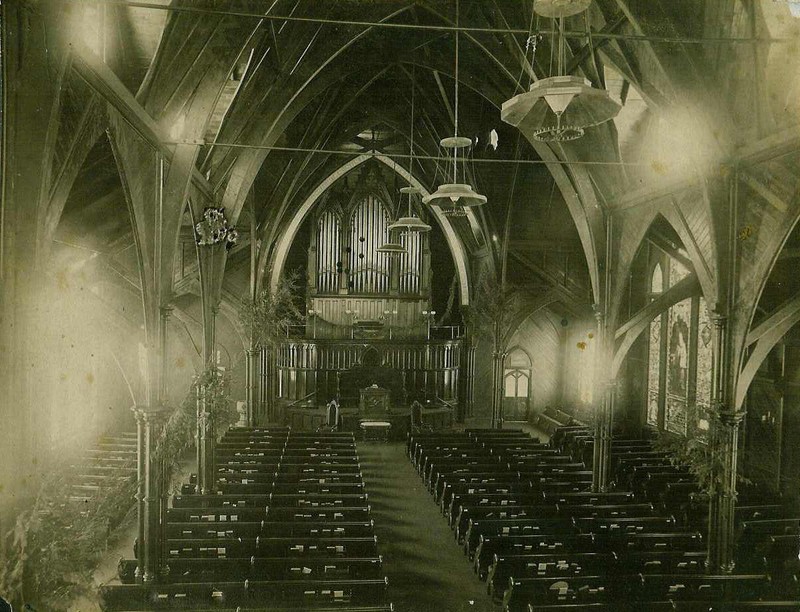St. John's Presbyterian Church
Introduction
Text-to-speech Audio
From 1905 to 1906, this church building was constructed for Saint John's Presbyterian Church, designed in a combination of Gothic Revival, Romanesque, and Shingle styles with a corner pyramidal tower. Barely a week after the first church service in the new building, the great earthquake of April 1906 struck San Francisco; the resulting fires did not reach this spot, and the building suffered only minor damage. The repaired church building reopened in April 1907. A large round stained-glass window from 1866 that was created for the church's first building (that the new congregation purchased from an Episcopal congregation in 1870) was reused in their second building in 1889 and installed in the third church. Other stained-glass windows, wooden pews, and an 1872 organ also were recycled from the prior church(es). The building was added to the National Register of Historic Places in 1996 for its architectural significance and still houses an active congregation.
Images
View across intersection to St. John's Presbyterian Church in 2008 (Sanfranman59)

Entry door on north side of steeple tower; handicapped ramp added 1989 (Mrs. Bland Platt 1995)

An interior photo of the second location of St. John's Church, at California and Octavia Streets

View down the main aisle in 1995, below a Craftsman style chandelier (Platt)

1860s Rose Window in St. John's Presbyterian (Platt 1995)

Backstory and Context
Text-to-speech Audio
The original building used by the St. John's congregation, constructed 1866-1867 as St. James Episcopal Church, is no longer standing and was located at Post and Mason Streets. A Johnson organ, purchased for $10,000, was shipped to San Francisco from Boston in 1872. Another local Presbyterian congregation, Calvary Presbyterian Church, had named Dr. William Anderson Scott as pastor. Dr. Scott and his family first arrived in San Francisco in 1854 from New Orleans. He began preaching in the Music Hall at Montgomery and Bush Streets and quickly raised money to build Calvary Presbyterian Church. On October 5, 1856, he was hanged in effigy from a lamppost at Bush and Montgomery because of his opposition to the Committee of Vigilance, a vigilante militia that had formed in response to mass amounts of crime. This happened again in 1861, this time outside his church, for including Jefferson Davis, President of the Southern Confederacy, in his public prayers. This forced the doctor and his family to leave the city promptly, and they went by steamer to Panama, then to England, Paris, and back to England before taking up a pastorate in New York City.
Reverend Scott returned to San Francisco in 1868 hoping to become pastor of Calvary Presbyterian once again but was invited to become the first pastor of a new congregation. A group of parishioners of Calvary Presbyterian, including industrialist Henry Mayo Newhall (1825-1882), formed the St. John's Presbyterian congregation in 1869. Rev. Scott, a close friend of Newhall, remained at St. John's until his death in 1885. Most notably perhaps, in 1880, Dr. Scott married Robert Louis Stevenson and Fannie Osborne in his study. St. John's congregation relocated to a new building on California and Octavia Streets in 1889; the round stained-glass Rose Window was among the features of the first church that were brought to the new location.
At the beginning of the 20th century, the St. John's congregation decided to build a new church. Church trustee Arthur W. Foster donated the land for the building at Arguello and Lake Streets and much of the construction funding; Foster had married Rev. Scott's daughter, Louisiana, in 1876. The design was by architects Dodge & Dolliver, a brief partnership of George A. Dodge and J. Walter Dolliver. The interior was meant to be similar to the Gothic style seen in the first and second churches; the transcept arch at the front of the church was widened so that two new stained-glass windows could be installed, honoring Rev. Scott and Mr. Newhall. Many of the stained-glass windows in the third church were reused from the first and second locations; one window honored the parents of Foster. The wooden arch spanning the pulpit, the wooden pews, and the 1872 organ from the previous church buildings also were recycled. Ground was broken on April 25th, 1905, and the first service was on Easter Sunday, April 15th, 1906. Three days later the great earthquake struck, damaging much of the building quite badly. Fortunately, a year later, repairs were completed, and the church was rededicated on April 28th, 1907. By the time the church celebrated its Golden Jubilee (50th) anniversary in 1920, its pastor was William Anderson Philips. Two stained-glass windows were added in the 1920s. The church was enlarged by an addition off of its west end in 1913 (first floor-auditorium) and 1949 (2nd floor-chapel).
Sources
Noe Hill. San Francisco Landmark #83 Saint John's Presbyterian Church. Accessed May 21, 2017. http://noehill.com/sf/landmarks/sf083.asp.
Platt, Mrs. Bland. NRHP Nomination, St. John's Presbyterian Church, San Francisco, CA. National Register of Historic Places. Washington, DC. National Park Service, 1995.
St. John's Episcopal Church. History. St John SF. Accessed May 21, 2017 and June 10th, 2025. http://www.stjohnssf.org/history.php.
https://en.wikipedia.org/wiki/National_Register_of_Historic_Places_listings_in_San_Francisco#/media/File:St_Johns_Presbyterian_Church_(San_Francisco)_2.JPG
National Park Service (NPS): https://npgallery.nps.gov/AssetDetail/NRIS/95001555
NPS: https://npgallery.nps.gov/AssetDetail/NRIS/95001555
NPS: https://npgallery.nps.gov/AssetDetail/NRIS/95001555
NPS: https://npgallery.nps.gov/AssetDetail/NRIS/95001555
